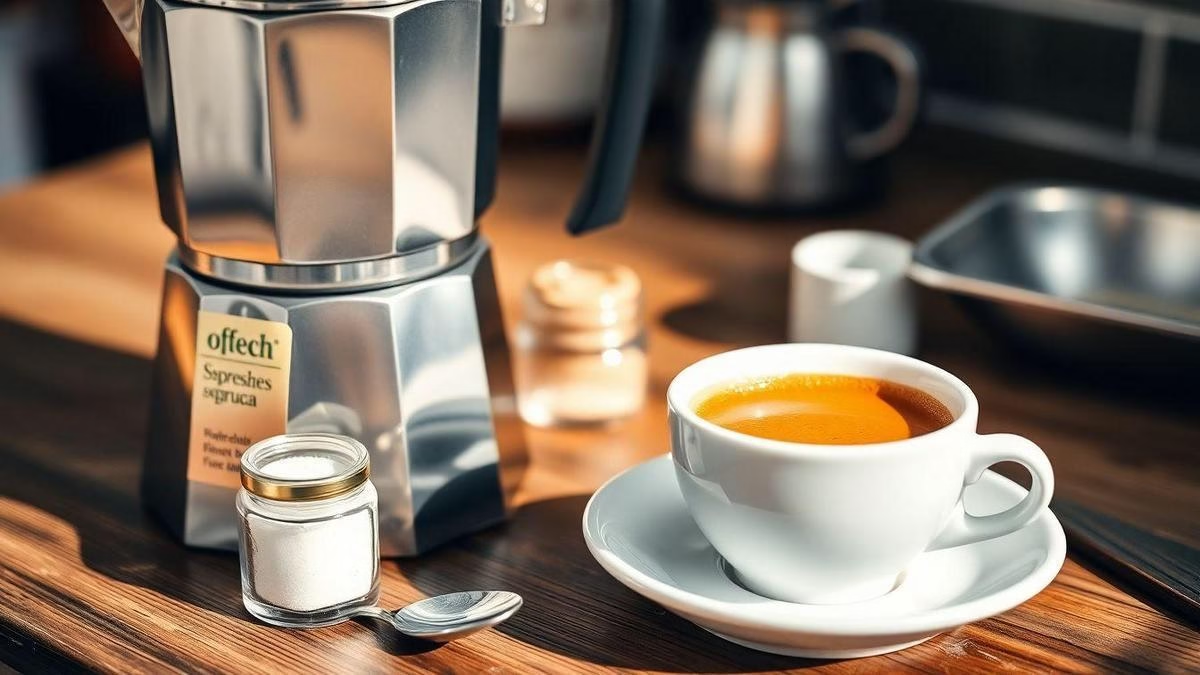Complete Guide to Brewing Cuban Coffee at Home
Complete Guide to Brewing Cuban Coffee at Home helps you master every step: choose bold dark roast beans and keep them fresh, set up a cafetera (Moka) pot and brew without bitterness, make fluffy espuma and fold it into sweet cafecito, prepare a warm colada to share, and troubleshoot common problems. Simple tips. Real flavor. Friendly and clear.
Key Takeaway
- Grind coffee very fine for a rich, bold cup.
- Pick a dark, sweet roast for authentic Cuban taste.
- Brew with a Moka pot (cafetera) or espresso maker for strong coffee.
- Whip sugar with the first brewed coffee to make creamy espuma.
- Pour into small cups and enjoy it hot.
How you pick the best coffee beans for Cuban coffee when brewing Cuban coffee at home
When you want real Cuban coffee at home, start with the beans. For an authoritative overview of bean varieties and roast profiles, see History and types of coffee beans. Look for dark roasts and blends that lean toward bold, bittersweet notes. The aroma should be toasty with chocolate and caramel hints — that smell is half the trip to Havana before your first sip. This Complete Guide to Brewing Cuban Coffee at Home will walk you through choices so you get that strong, syrupy cup.
Think about how you brew: Cuban coffee is often made in a Moka pot or small espresso brewer, and those methods like a tight, rich flavor. Beans roasted dark and blended for espresso give you the syrupy body and slight smoky edge that stand up to sugar or milk. Light, floral beans will taste thin in this style.
Freshness matters. Buy small batches with roast dates and keep whole beans until you brew. For storage and selection tips, see How to store and select beans. Grind right before brewing to preserve oils and aroma.
“A good cup of Cuban coffee is like a warm hello — bold, quick, and impossible to ignore.”
Choose dark‑roast blends from Cuba or Latin America for authentic flavor
Dark roasts from Cuba or nearby Latin American countries give the classic profile: deep chocolate, caramelized sugar, and a touch of smoke. Look for blends labeled for espresso or strong coffee; these mixes balance bitterness and sweetness. Some Cuban-style blends include robusta for extra body and crema — fine if you want an old‑school punch.
Blends often beat single‑origin beans for this style because they mix strengths from different regions: body from one lot, sweetness from another, and a dark roast finish that ties it together.
| Origin | Roast level | Typical notes |
|---|---|---|
| Cuba / Puerto Rico | Dark | Smoky, chocolate, caramel |
| Nicaragua / Honduras | Dark‑medium to Dark | Nutty, sweet, balanced body |
| Brazil | Dark | Cocoa, low acidity, heavy body |
Buy whole beans and grind just before brewing to keep freshness
Grind only what you’ll use that day. For a Moka pot, aim for a fine grind — finer than drip, a bit coarser than espresso — so water passes with pressure but doesn’t over‑extract and taste bitter. Avoid pre‑ground coffee when possible.
Tip: Grind only what you’ll use that day. If you brew twice a day, grind twice.
Store beans airtight, away from light and heat for longer flavor
Keep beans in an opaque, airtight container in a cool, dark spot. Avoid the fridge or freezer for daily beans — moisture and odors can ruin them. Use within two to four weeks of opening for best results.
How you set up and use a cafetera (Moka) pot
Setting up your Moka pot is quick. Unscrew the top from the base and remove the filter funnel. Fill the base with fresh, hot water up to the safety‑valve level — not over it — so pressure stays steady. Spoon in medium‑fine ground coffee into the funnel without tamping; level it lightly.
For a tested walkthrough on water level, grind, and timing, see Step by step Moka pot guide. Screw the top on snugly and place the pot on low to medium heat so the water lifts slowly through the grounds. When the coffee gurgles and rises, take the pot off heat the moment the flow slows to a sputter. That keeps bitterness out and preserves sweet oils.
Fill the base to the safety‑valve level and use medium‑fine grind
Fill to the safety valve. Too little water gives weak coffee; too much risks spitting and poor extraction. Use hot water from a kettle to speed brewing and reduce time on heat.
The right grind is medium‑fine — finer than drip, coarser than espresso. Don’t tamp the grounds. Check the safety valve regularly for clogs; clean with a pin and replace if damaged.
| Item | What to do | Why it matters |
|---|---|---|
| Water level | Fill to valve line | Keeps correct pressure |
| Grind | Medium‑fine | Balanced extraction |
| Packing | No tamping | Prevents overpressure and bitterness |
Heat gently until coffee gurgles, then remove from heat to avoid bitterness
Use low to medium heat so the water warms slowly. High heat forces flavors and robs subtlety. When the first steady stream appears, watch the color; when it turns honey‑amber to deep brown and slows to a sputter, pull the pot and let the last drops finish on residual heat.
Tip: If your kitchen gets loud, watch the color of the coffee in the top chamber as much as you listen.
Tighten parts and check the gasket for a safe, even extraction
Tighten the top securely but don’t force it. Inspect the rubber gasket and filter plate for cracks or buildup. Replace worn parts so every brew is even.
How you make espuma for cafecito (Cuban cafecito technique)
The Cuban cafecito trick is simple: take the first few drops of very strong espresso and mix them with white sugar, then whip until pale and creamy. That sweet foam — espuma or espumita — sits on top of your coffee and makes every sip sing. Mastering espuma changes the whole feel of the cup and is central to this Complete Guide to Brewing Cuban Coffee at Home.
Use a dark roast, finely ground, and pull a short, strong shot. Save the first 1–2 teaspoons — they’re concentrated and perfect for the foam. Whip those drops with sugar until you see a syrupy, light beige paste, then fold that foam into the rest of your coffee so it floats and flavors each sip.
| What you need | Amount |
|---|---|
| Strong espresso (single shot) | 25–30 ml |
| First drops reserved for espuma | 1–2 tsp |
| White sugar | 1 tbsp per shot |
| Tools | Small spoon, demitasse or tiny bowl, small whisk or handheld frother |
Use the first few drops of strong espresso and a spoon of white sugar
Catch the first drops as the shot starts and mix them with white granulated sugar. White sugar dissolves quickly and helps create a stable, shiny paste that defines Cuban cafecito.
“My abuela always said: the first drops are the soul of the cafecito.”
Beat sugar and first drops until pale and creamy, then fold back into coffee
Whip quickly with short, fast strokes for 15–30 seconds, or use a small electric frother in short pulses. You want a thick, pale paste that holds its shape briefly when lifted. Scoop it back into the cup and pour the remaining coffee over it slowly so the foam sits on top.
Practice quick whisking or use a small mixer for consistent espuma every time
If you’re short on muscle, a battery frother saves time and gives consistent results. Practice the brisk motion and timing for reliable espuma.
Simple Cuban coffee recipe (steps)
You can make a real Cuban cafecito with a few clear steps and common gear. This short path from the Complete Guide to Brewing Cuban Coffee at Home gets you to a sweet, foamy espresso in minutes.
- Grind beans fine, use hot water in the Moka pot, and brew slowly over low heat.
- Reserve the first 1–2 tsp of the brew and whip with sugar into espuma.
- Fold the espuma into the rest of the coffee and serve hot in small cups.
Cafecito is often called comfort in a cup — quick, sweet, and shared with friends.
Brew strong in the Moka pot using fine grounds and low heat
Use a fine espresso grind, fill the bottom chamber with hot water to the safety valve, fill the basket with grounds (no tamping), screw the top on snugly, and set on low heat. Remove at the first strong gurgle and let the last drops finish off heat.
Mix brewed coffee with the espuma to make sweetened espresso Cuban style
Pour the first tablespoons into a small cup with sugar and whip into espuma. Then pour the rest of the coffee over it, folding gently to keep foam on top.
Callout: If you’re short on muscle, use an electric frother.
Use a 1:1 to 1:2 sugar‑to‑coffee ratio for classic cafecito sweetness
- 1:1 (very sweet) — equal parts sugar to coffee.
- 1:2 (lighter) — half as much sugar.
| Brew size (approx) | 1:1 (sweet) | 1:2 (less sweet) |
|---|---|---|
| 30 ml (1 oz) shot | 1 tsp sugar | 1/2 tsp sugar |
| 60 ml (2 oz) | 2 tsp sugar | 1 tsp sugar |
How you prepare and share a colada (Cuban coffee) and serve it like locals
A colada is a communal ritual: brew strong shots, whip each first stream into espumita, and pour multiple sweetened shots into a larger cup for sharing. This method is part of the Complete Guide to Brewing Cuban Coffee at Home and shows the rhythm: brew, sweeten, whip, and share.
Make the espumita from the very first drops in a metal cup with sugar, beat until pale and foamy, then pour the rest of the espresso over it. Repeat for each shot and pour into the big sharing cup. Serve quickly so foam remains fluffy.
Pour multiple sweetened shots into a larger cup for sharing among friends
Prepare 2–6 shots depending on group size. For each shot, make espumita and pour the sweetened shot into the big cup, aiming for a bowl of concentrated, sweet espresso with a layer of foam on top.
| Shots (strong espresso) | Sugar per shot | Serves (small cups) |
|---|---|---|
| 1–2 | 1–2 tsp | 2 people (quick taste) |
| 3–4 | 1–2 tsp each | 4–6 people (classic colada) |
| 5–6 | 1–2 tsp each | 6–8 people (larger gathering) |
Tip: Make espumita from the very first drops off the pot. Whip until pale, pour the rest over it, and serve immediately.
Use small cups and spoons so everyone can enjoy the espuma
Small demitasses or disposable cups highlight the espuma and force slow sipping. Give everyone a small spoon to scoop the foam. For gatherings, choose compostable cups and wooden spoons if you care about waste.
Serve hot and quick so the espuma stays fluffy during a colada gathering
Foam collapses as coffee cools. Work in bursts: brew a few shots, serve, then brew more. Keep extra pots ready and move fast.
Moka pot tips and troubleshooting for brewing Cuban coffee at home
Treat the Moka pot as the stage for Cuban coffee: fresh dark-roast beans, fine grind, water to the safety valve, grounds not packed, and snug top. If you want technical resources on grind and extraction to troubleshoot issues, see Grind size and extraction guidance. Heat control and timing decide the difference between a lively cup and a burnt one.
Common culprits:
- Sour = under‑extraction or stale beans.
- Bitter = over‑extraction or too much heat.
- Weak = too little coffee or a coarse grind.
Fix sour taste by using fresher beans or adjusting grind slightly finer
Sourness usually signals under‑extraction. Use beans roasted within a few weeks, grind just before brewing, and move the grind a notch finer. If the pot brews too quickly, lower the heat or preheat the water to stabilize extraction.
Cut bitterness by lowering heat and removing the pot at the first strong gurgle
Bitterness often comes from too much heat or too long a brew. Lower the flame and remove the pot at the first strong gurgle. If the grind is too fine or the basket packed, try a coarser setting and don’t press down.
Keep a brewing log of grind, heat, and bean type to repeat your best cup
Note bean name and roast date, grind setting, dose, heat level, time to gurgle, and sugar amount for espumita. Short tasting notes help you reproduce your favorite cup.
Tip: For real Cuban-style foam, mix the first 1–2 tablespoons of brewed coffee with 1–2 teaspoons of sugar and whisk until light and pale, then pour the rest of the coffee over it.
| Symptom | Likely cause | Quick fix |
|---|---|---|
| Sour (tart, thin) | Beans stale or grind too coarse; fast brew | Use fresher beans, grind slightly finer, lower heat |
| Bitter (sharp, burnt) | Too hot, too long, or too fine grind | Lower flame, remove at first gurgle, coarsen grind |
| Weak (watery) | Too little coffee or too coarse grind | Increase dose, finer grind |
| Burnt/metallic | Pot overheated or old residue | Clean pot, use lower heat, preheat water |
Quick checklist from the Complete Guide to Brewing Cuban Coffee at Home
- Use dark roast espresso‑style beans, whole and fresh.
- Grind just before brewing; fine for Moka but not powdered.
- Fill Moka base to safety valve, use hot water.
- Brew on low heat; remove at first strong gurgle.
- Reserve first drops, whip with granulated sugar into espuma.
- Fold espuma onto coffee, serve hot in small cups or as a colada to share.
Conclusion
You’ve got the roadmap to brew authentic Cuban coffee at home. Start with dark roast beans, grind just before brewing, and use a Moka pot over low heat. Catch the very first drops, whip them with white sugar into glossy espuma, and fold that sweetness back into your cup. Simple steps. Big reward.
Keep it practical: fresh beans, base to the safety‑valve line, no tamping, and stop the brew at the first strong gurgle. If your cup tastes sour, go finer or use fresher beans. If it’s bitter, lower the heat and stop earlier. A short brewing log helps you repeat the magic.
This is less science and more ritual. With practice you’ll turn your kitchen into a tiny Havana corner. Make a colada to share, savor the foam, and pass stories along with each small cup. You’re ready—give it a whirl and tweak until it sings.
For more tips, recipes, and friendly coffee wisdom, read more at https://guiabebefeliz.com.

Rafael Souza is a digital marketing specialist and passionate coffee enthusiast. He founded Guiabebefeliz to share practical, easy-to-follow guides for making great coffee at home without needing professional barista skills. His mission is to help readers enjoy better coffee experiences, one cup at a time.






